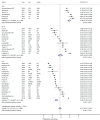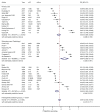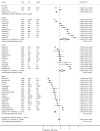Survival of patients with chronic heart failure in the community: a systematic review and meta-analysis
- PMID: 31523902
- PMCID: PMC6919428
- DOI: 10.1002/ejhf.1594
Survival of patients with chronic heart failure in the community: a systematic review and meta-analysis
Abstract
Aim: To provide reliable survival estimates for people with chronic heart failure and explain variation in survival by key factors including age at diagnosis, left ventricular ejection fraction, decade of diagnosis, and study setting.
Methods and results: We searched in relevant databases from inception to August 2018 for non-interventional studies reporting survival rates for patients with chronic or stable heart failure in any ambulatory setting. Across the 60 included studies, there was survival data for 1.5 million people with heart failure. In our random effects meta-analyses the pooled survival rates at 1 month, 1, 2, 5 and 10 years were 95.7% (95% confidence interval 94.3-96.9), 86.5% (85.4-87.6), 72.6% (67.0-76.6), 56.7% (54.0-59.4) and 34.9% (24.0-46.8), respectively. The 5-year survival rates improved between 1970-1979 and 2000-2009 across healthcare settings, from 29.1% (25.5-32.7) to 59.7% (54.7-64.6). Increasing age at diagnosis was significantly associated with a reduced survival time. Mortality was lowest in studies conducted in secondary care, where there were higher reported prescribing rates of key heart failure medications. There was significant heterogeneity among the included studies in terms of heart failure diagnostic criteria, participant co-morbidities, and treatment rates.
Conclusion: These results can inform health policy and individual patient advanced care planning. Mortality associated with chronic heart failure remains high despite steady improvements in survival. There remains significant scope to improve prognosis through greater implementation of evidence-based treatments. Further research exploring the barriers and facilitators to treatment is recommended.
Keywords: Heart failure; Meta-analysis; Prognosis; Survival analysis; Systematic review.
© 2019 The Authors. European Journal of Heart Failure published by John Wiley & Sons Ltd on behalf of European Society of Cardiology.
Figures





Comment in
-
Decelerating trends in heart failure survival.Eur J Heart Fail. 2019 Nov;21(11):1326-1328. doi: 10.1002/ejhf.1626. Eur J Heart Fail. 2019. PMID: 31746110 No abstract available.
-
Survival rates in elderly patients with heart failure.Eur J Heart Fail. 2020 Mar;22(3):566. doi: 10.1002/ejhf.1712. Epub 2019 Dec 16. Eur J Heart Fail. 2020. PMID: 31840348 No abstract available.
-
Survival rates in elderly patients with heart failure: reply.Eur J Heart Fail. 2020 Mar;22(3):566-567. doi: 10.1002/ejhf.1751. Epub 2020 Feb 5. Eur J Heart Fail. 2020. PMID: 32020746 No abstract available.
References
-
- Bleumink GS, Knetsch AM, Sturkenboom MC, Straus SM, Hofman A, Deckers JW, Witteman JC, Stricker BH. Quantifying the heart failure epidemic: prevalence, incidence rate, lifetime risk and prognosis of heart failure. The Rotterdam Study. Eur Heart J 2004;25:1614–1619. - PubMed
-
- van Riet EE, Hoes AW, Wagenaar KP, Limburg A, Landman MA, Rutten FH. Epidemiology of heart failure: the prevalence of heart failure and ventricular dysfunction in older adults over time. A systematic review. Eur J Heart Fail 2016;18:242–252. - PubMed
-
- Ceia F, Fonseca C, Mota T, Morais H, Matias F, de Sousa A, Oliveira A; EPICA Investigators. Prevalence of chronic heart failure in Southwestern Europe: the EPICA study. Eur J Heart Fail 2002;4:531–539. - PubMed
-
- Rutten FH, Cramer MJ, Grobbee DE, Sachs AP, Kirkels JH, Lammers JW, Hoes AW. Unrecognized heart failure in elderly patients with stable chronic obstructive pulmonary disease. Eur Heart J 2005;26:1887–1894. - PubMed
Publication types
MeSH terms
Grants and funding
LinkOut - more resources
Full Text Sources
Medical

